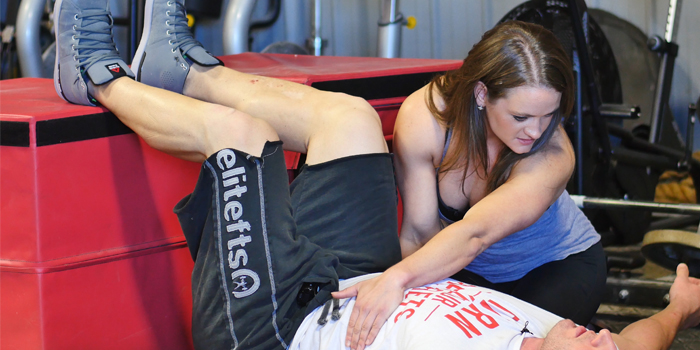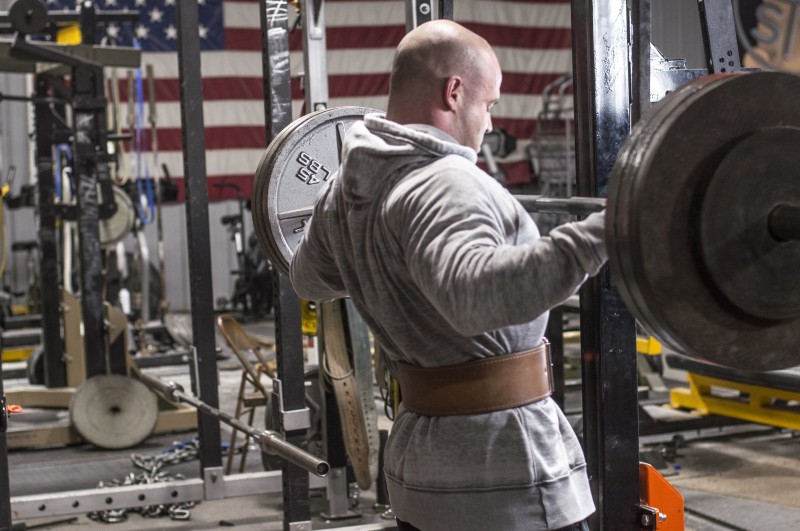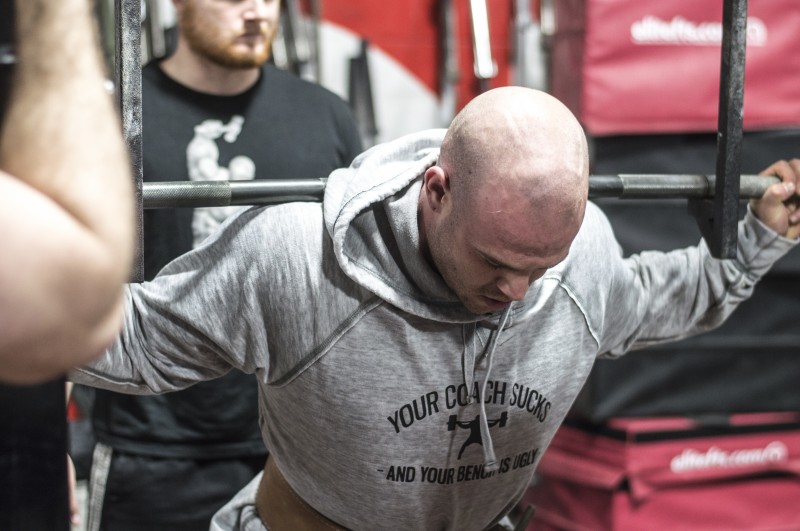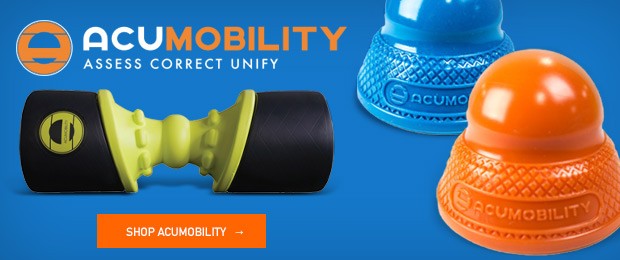
Oh, glutes. We talk about them constantly. We do activation drills, alternate stances and main movements to target them, and it seems like nine times out of ten there’s something in us that knows that if/when injury occurs, getting glutes working more efficiently and strengthening them is somewhere in the mix of improving the situation.
There’s a lot of talk about anterior pelvic tilt and how important it is to maintain neutral spine in all our lifting to help maintain glute activation; a neutral spine/pelvis will decrease the preference to utilize something other than a glute to achieve full extension. Yes, this is true — but maybe we need to change our reference center temporarily.
Casey and I just put out a series of articles and videos regarding how we worked to modify his pelvis position to decrease hamstring and adductor stress. We achieved this primarily by facilitating a few key muscle groups (obliques, diaphragm, glutes) to decrease the amount of pelvic tilt during movement and prevent the low back pump many of us know too well.
It worked beautifully for him, but truthfully I think we got a little lucky. Casey thinks his ankle mobility is trash, but given he’s squatted in flats rather than a heeled shoe for a while, he’s probably maintained it better than he thinks. Had he been squatting in heels, I think it’d have been more difficult to modify his pelvis position. Remember, pelvis position is a huge contributor to which muscles become a natural preference to perform a movement. Want a glute? Better make sure it’s in a position and pattern to function properly.
So what’s the deal with feet?
If you can’t dorsiflex or bend your ankle—not just forward/backward but also small degrees of in/out—your center of gravity is shifted, and you’re essentially permanently pitched forward.Dramatization, but you get the point.
RECENT: Training for Movement — 4 Easy Program Fixes
Stand up, and get a feel for your feet on the floor. Notice where your center of gravity is. Take a few mental notes for where you are in your low back, pelvis, and where your weight is distributed on your feet — forward, backward, and outside/inside of your feet.
Now, arch your back into the anterior tilt or bilateral hyperlordosis. I mention this not to get lost, but because many of us are more lordotic on one side than the other — check your erectors and lat development. This contributes to chronic low back pump, decreased glute activation, and increased hamstring/adductor strain. It was the root of a lot of the problems Casey had that we worked on.
What happens to your feet? You’re likely forward or on your toes.
Now try it in reverse: Stand in your body’s proprioceptive normal, then shift your weight onto your toes, similar to if you were in a heeled shoe, and get a sense for increased activation, tightness, tone level, and where you feel it. You’ll likely feel your pelvis tip forward, low back turn on, neck tighten up, and calves turn on more.
Zoom out, and imagine you have 80% of your max on your back for a few sets. Even with all your hip/low back rehab dialed in, if where your body feels the ground doesn’t have the ability to control your body weight, you’re still going to fall back into a variation of the pattern your body has utilized to accommodate. Your body’s smart enough to cheat where it can, even if it’s the same pattern that causes your dysfunction.
That pelvic tilt that comes back when you shift your weight on your feet? That’s your body’s way of staying upright. And that happened by shifting your weight to proprioceptively change where your body’s reference center is — and is counterproductive to the glute activation, core activation, breathing drills, bracing drills, and most other rehab-based protocol you’re using.
In our lifts, with as much load as we carry and the need to stay upright against gravity, every time we move, our body is going to try to find or achieve stability somewhere. The concept of a reference center could be thought of as your body’s anchoring system: when the other parts are moving or appropriately unstable, you need to be grounded somewhere.
For Casey, and a lot of us, our low back becomes our reference center. Those low back pumps, if you get them, are a good indication that it’s become the interface for translation between your body and your brain. You’re optimizing low back muscles to leverage pelvic position.
But if that can change based on your feet/ankles, if you’ve addressed pelvis position and your mobility, mechanics, or pain aren’t changing, consider that your neurological reference center may need to shift. Shift it to your heels.
One of the best cues I used when my squat skyrocketed was switching to low bar and the cue of “finding my feet,” even in a heeled shoe. If your grounding (where your feet contact the floor) is lacking in appropriate mobility, there’s a chance it may be a key player in your hip pain, back pain, hip shift, or overhead mobility and stability.
We think about our squat and deadlift from the pelvis down. Reverse your thinking if that isn’t working, and rebuild from the bottom up.
There are two major contributors to ankle mobility:
- Joint Restriction
- Soft Tissue Restriction
Honestly? Just address both. I’m as bad as the rest of you about rehab stuff and carving out the time (part of why I know so well how this feels under the bar), but this is one of those that if you don’t address, you’re just lazy.
The joint has to be able to move, but whether you want to think about this from the mechanical perspective mentioned above where a change in center of gravity leverage changes demands on overall extension patterning or more from the myofascial mobility standpoint, the goal is to decrease the extension pattern enough to permit the glute/oblique patterning to stick.
Here a few of my favorite drills that I use routinely. None of these are remotely complex or fancy, but we far underrate the role of ankle mobility in low back and hip health in both the squat and conventional deadlift.
1. Mobilization with Movement: Keeping your foot flat on the ground, descend into a half or partial lunge (or go into the half kneeling position) and gradually advance your shin over your ankle. You can add a band around your ankle joint pulling back as you do this for a little extra help. One of the reasons I prefer this is that your foot is still flat on the ground, so any degree of foot pronation/supination can be monitored a little more easily. Often times with this we tend to let our foot collapse down pretty easily. Try to keep it neutral and think about feeling your heel on the ground in your mind’s eye. Hold for five to six seconds. Try 10 of these letting your knee go out a bit and working into supination, and try 10 letting your knee come in slightly. We do need some foot pronation! We can’t ever supinate or find knees out if they’re always out. Work all directions.
2. Low Weight, High Rep Eccentric Calf Raises on the Hip Sled: Think about pulling your ankle “back” to seed the joint further back in the socket.
3. Calf SMR Rolling: The acumobility roller is really phenomenal for this. I’m not a huge fan of soft tissue work but there’s a time and place for it, and there’s a lot to be said for neural input to the calves to decrease overall extension patterning. Any Anatomy Trains fans out there will remember the foot/calf rolling to improve hamstring length for a toe touch.
MORE: Build Your Arch: Why Flat Feet Kill Your Squat
Then complete the drills with some sort of a squat pattern to re-integrate the improved mobility but be intentional about proprioception. My favorite for this is a kettlebell goblet squat, paused at the bottom to really get a sense of where your body is in space.
I just wrote to find your heels at the bottom of that goblet squat, but that may be too pre-meditated. The bottom line is that you’ve done this ankle mobility stuff to improve your back/pelvis position and likely proper muscle activation. This is where no one can give you the perfect cue; you have to feel it and own it. Know what you’re looking for. Most times, finding your heel but keeping your weight somewhere between your heel and mid-foot will permit upright torso position with both gluteal and oblique activation for proper bracing.
This is all important but I think the bigger picture is to make sure we don’t lose the “why.” Yes, ankle mobility is important. But I really want to reiterate that the purpose of this is to tie a few things together for those of you dealing with low back, SI, or hamstring issues who think you have all the right things in place regionally. You may. So if you do, but your pain or patterning isn’t changing, look globally. Instead of thinking pelvis down or proximal to distal, think about where your body is anchored and consider looking from the ground up.













1 Comment